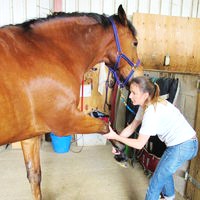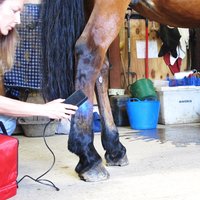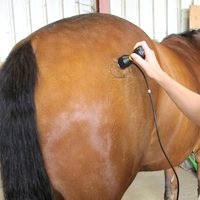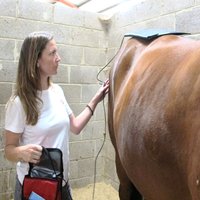Equine conditions and physiotherapy goals
Is your horse ;
- Out of work due to a ligament, tendon or muscular injury?
- Slowing down due to old age?
- Displaying unusual behaviour / mobility problems?
- A competing athlete needing to be working at it’s very best or seeming to have lost their ‘edge’?
- Suffering from skin conditions (e.g. rain scald / mud fever)?
- Experiencing difficulties in wound healing (e.g. infection or proud flesh)?
- Lost condition?
- Suffering due to an orthopaedic condition?
Ageing horse
As your horse ages you may see a visible reduction in muscle tone, increased muscle and joint stiffness and the onset of degenerative joint disease. All of these issues will cause the horse discomfort and often secondary pain in compensatory areas.
Physio can : help in pain management, ease muscle soreness, rebuild weakened muscles for the necessary support and encourage healthy elasticity back to fibrous connective tissues.
Your horse : will have improved mobility form and function, decreased pain and and overall improvement in their quality of life.
The Sports Horse
The competing athlete, whether driving, racing or eventing, can endure excessive stresses and strains to certain joints and muscle groups depending upon the discipline. This can impede them from working at their peak through restricted mobility, injury and pain. Whether you feel your horse is resisting certain movements, or always knocking that pole down, physiotherapy can resolve those niggling issues and enable your horse to perform to the best of it’s ability, work through those often unexplained barriers and take you both onto to bigger and better things.
Physio can : condition your horse both pre and post event, help to reduce pain, ensure areas of muscle spasm and soreness are identified and resolved allowing maximum range of movement and flexibility, help to effectively heal ligament / tendon injuries, address imbalances and asymmetry, strengthen weakened muscles and reduce the risk of further injury.
Your horse : will have increased range of movement, flexibility and balance, movement will be more comfortable and as a result your horse will be more able and willing to take on the challenges given to them.
Is your horse ;
- Out of work due to a ligament, tendon or muscular injury?
- Slowing down due to old age?
- Displaying unusual behaviour / mobility problems?
- A competing athlete needing to be working at it’s very best or seeming to have lost their ‘edge’?
- Suffering from skin conditions (e.g. rain scald / mud fever)?
- Experiencing difficulties in wound healing (e.g. infection or proud flesh)?
- Lost condition?
- Suffering due to an orthopaedic condition?
Ageing horse
As your horse ages you may see a visible reduction in muscle tone, increased muscle and joint stiffness and the onset of degenerative joint disease. All of these issues will cause the horse discomfort and often secondary pain in compensatory areas.
Physio can : help in pain management, ease muscle soreness, rebuild weakened muscles for the necessary support and encourage healthy elasticity back to fibrous connective tissues.
Your horse : will have improved mobility form and function, decreased pain and and overall improvement in their quality of life.
The Sports Horse
The competing athlete, whether driving, racing or eventing, can endure excessive stresses and strains to certain joints and muscle groups depending upon the discipline. This can impede them from working at their peak through restricted mobility, injury and pain. Whether you feel your horse is resisting certain movements, or always knocking that pole down, physiotherapy can resolve those niggling issues and enable your horse to perform to the best of it’s ability, work through those often unexplained barriers and take you both onto to bigger and better things.
Physio can : condition your horse both pre and post event, help to reduce pain, ensure areas of muscle spasm and soreness are identified and resolved allowing maximum range of movement and flexibility, help to effectively heal ligament / tendon injuries, address imbalances and asymmetry, strengthen weakened muscles and reduce the risk of further injury.
Your horse : will have increased range of movement, flexibility and balance, movement will be more comfortable and as a result your horse will be more able and willing to take on the challenges given to them.
Infections / Skin Conditions
Is your horse prone to suffering from bacterial skin conditions such as mud fever or rain scald, or do they have an open wound which runs the risk of infection?
Physio can : reduce the infection and clear up these bacterial skin conditions through phototherapy application. The treated area becomes a hostile environment for bacteria discouraging colonisation and clearing already established infections.
Your horse : is much more comfortable with reduced risk of infections taking hold and therefore increased opportunity of wound healing. It is an excellent tool for maintaining an infection free area where horses are particularly adverse to daily cleaning and hands on contact with the sensitive and often sore area. Phototherapy removes this necessity.
Soft Tissue Injury
As all horse owners know injuries are often incurred whether through a kick in the field, strenuous activity, lack of fitness for the job at hand, a fall or slip, repetitive concussive movements or simply as a result of specific conformation. The results can be an open wound, strain or sprain or a torn or ruptured muscle, tendon or ligament and without the proper attention can result in proud flesh formation or permanent weak spots predisposed to future reinjury and scar tissue and adhesions restricting optimum movement and flexibility.
Physio can : increase the rate and effectiveness of muscle / tendon / ligament healing encouraging correct alignment and ‘type’ of new tissue fibres ensuring strength and longevity in the healed soft tissue, manage pain, limit muscle atrophy, decrease the risk of onset of osteoarthritis, dramatically reduce the risk of compensatory muscle spasm - restoring range of movement and mobility, reduce scar tissue and adhesions, controlling swelling and inflammation, reduce formation of proud flesh / encourage correct wound healing.
Your horse : is given the best chance of recovery and return to fitness by reducing secondary muscle pain and spasm and ensuring optimum conditions for effective healing and enduring tissue strength whilst significantly reducing chances of re-injury.
Is your horse prone to suffering from bacterial skin conditions such as mud fever or rain scald, or do they have an open wound which runs the risk of infection?
Physio can : reduce the infection and clear up these bacterial skin conditions through phototherapy application. The treated area becomes a hostile environment for bacteria discouraging colonisation and clearing already established infections.
Your horse : is much more comfortable with reduced risk of infections taking hold and therefore increased opportunity of wound healing. It is an excellent tool for maintaining an infection free area where horses are particularly adverse to daily cleaning and hands on contact with the sensitive and often sore area. Phototherapy removes this necessity.
Soft Tissue Injury
As all horse owners know injuries are often incurred whether through a kick in the field, strenuous activity, lack of fitness for the job at hand, a fall or slip, repetitive concussive movements or simply as a result of specific conformation. The results can be an open wound, strain or sprain or a torn or ruptured muscle, tendon or ligament and without the proper attention can result in proud flesh formation or permanent weak spots predisposed to future reinjury and scar tissue and adhesions restricting optimum movement and flexibility.
Physio can : increase the rate and effectiveness of muscle / tendon / ligament healing encouraging correct alignment and ‘type’ of new tissue fibres ensuring strength and longevity in the healed soft tissue, manage pain, limit muscle atrophy, decrease the risk of onset of osteoarthritis, dramatically reduce the risk of compensatory muscle spasm - restoring range of movement and mobility, reduce scar tissue and adhesions, controlling swelling and inflammation, reduce formation of proud flesh / encourage correct wound healing.
Your horse : is given the best chance of recovery and return to fitness by reducing secondary muscle pain and spasm and ensuring optimum conditions for effective healing and enduring tissue strength whilst significantly reducing chances of re-injury.
Orthopaedic conditions
The horse can encounter various orthopaedic issues including splints, navicular disease, pedal osteitis, fractures, ringbone or bone spavin. These often culminate in an abnormal gait / severe lameness, a change in behaviour or performance, primary pain or indeed secondary pain through compensatory postures e.g. often identified in the shoulder. These conditions can also unfortunately lead to secondary osteoarthritis.
Physio can : restore normal gait and optimise hoof function, minimize splint size, reduce direct muscle strain and spasm as well as compensatory pain.
Your horse : is given the best chance of recovery and return to fitness by ensuring optimum conditions for effective healing and enduring tissue strength whilst significantly reducing chances of re-injury.
The horse can encounter various orthopaedic issues including splints, navicular disease, pedal osteitis, fractures, ringbone or bone spavin. These often culminate in an abnormal gait / severe lameness, a change in behaviour or performance, primary pain or indeed secondary pain through compensatory postures e.g. often identified in the shoulder. These conditions can also unfortunately lead to secondary osteoarthritis.
Physio can : restore normal gait and optimise hoof function, minimize splint size, reduce direct muscle strain and spasm as well as compensatory pain.
Your horse : is given the best chance of recovery and return to fitness by ensuring optimum conditions for effective healing and enduring tissue strength whilst significantly reducing chances of re-injury.




